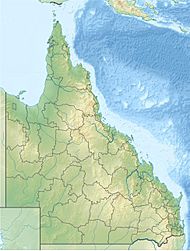Warro National Park facts for kids
Quick facts for kids Warro National ParkQueensland |
|
|---|---|
|
IUCN Category II (National Park)
|
|
| Nearest town or city | Gin Gin |
| Established | 2006 |
| Area | 60.32 km2 (23.3 sq mi) |
| See also | Protected areas of Queensland |
Warro National Park is a special protected area, like a big natural playground, located in Queensland, Australia. It's about 60 square kilometres (23 sq mi) in size, which is roughly the same as 6,000 football fields! This park was created in 2006 to protect its unique plants and animals.
Contents
Where is Warro National Park?
Warro National Park is found in the Wide Bay–Burnett region of Queensland. This area is often called the Sunshine Coast. The park is about 340 kilometres (210 mi) north of Brisbane, Queensland's capital city. It's also about 185 kilometres (115 mi) southeast of Rockhampton.
Getting to the Park
The closest town to Warro National Park is Gin Gin. From Gin Gin, you can reach the park by heading north on the Bruce Highway. After about 40 kilometres (25 mi), the highway runs next to the park's western side for about 6 kilometres (3.7 mi).
Nearby Natural Areas
In the south, Warro National Park touches Lake Monduran. However, there are no special places for visitors inside the park. Other national parks nearby include Bania, Bulburin, Littabella, and Mount Colosseum.
Plants and Animals of Warro National Park
This national park protects two main types of forests. One is a dry rainforest that can be up to 410 meters high. The other is an eucalyptus forest, full of gum trees.
Amazing Birds
The park is home to many different birds. You might spot the colorful coconut lorikeet (Trichoglossus haematodus moluccanus). Other birds include the rufous whistler (Pachycephala rufiventris), known for its lovely song. You could also see the grey shrikethrush (Colluricincla harmonica) and the noisy friarbird (Philemon corniculatus).
Frogs and Rare Plants
Many types of frogs live here, including species from the Hylidae family and common Australian frogs. One interesting frog is the Platyplectrum ornatum. The park also protects some very rare plant species. These include Argophyllum nullumense, Kunzea flavescens, and Eucalyptus decolor. Protecting these plants helps keep the park's environment healthy and special.


